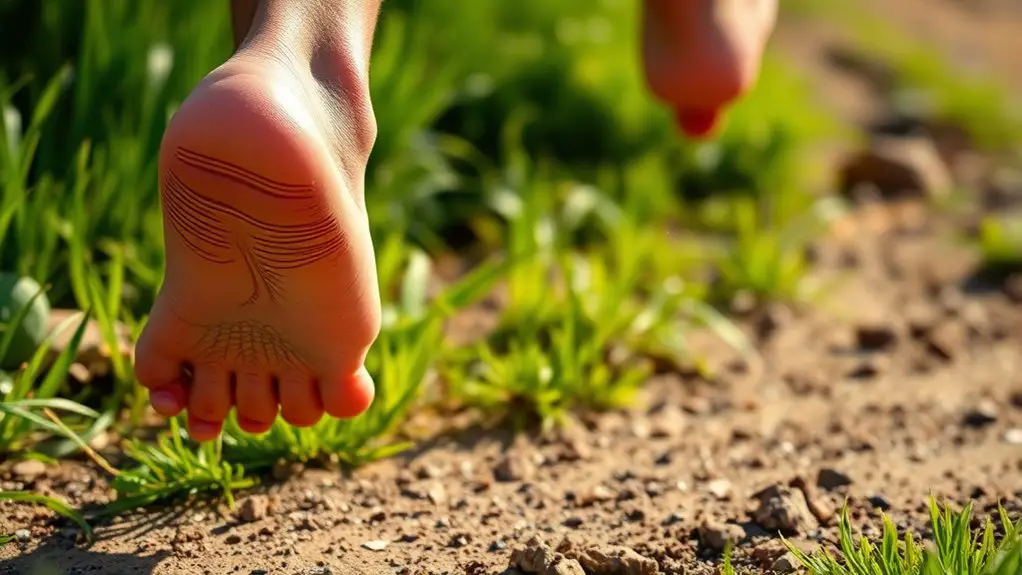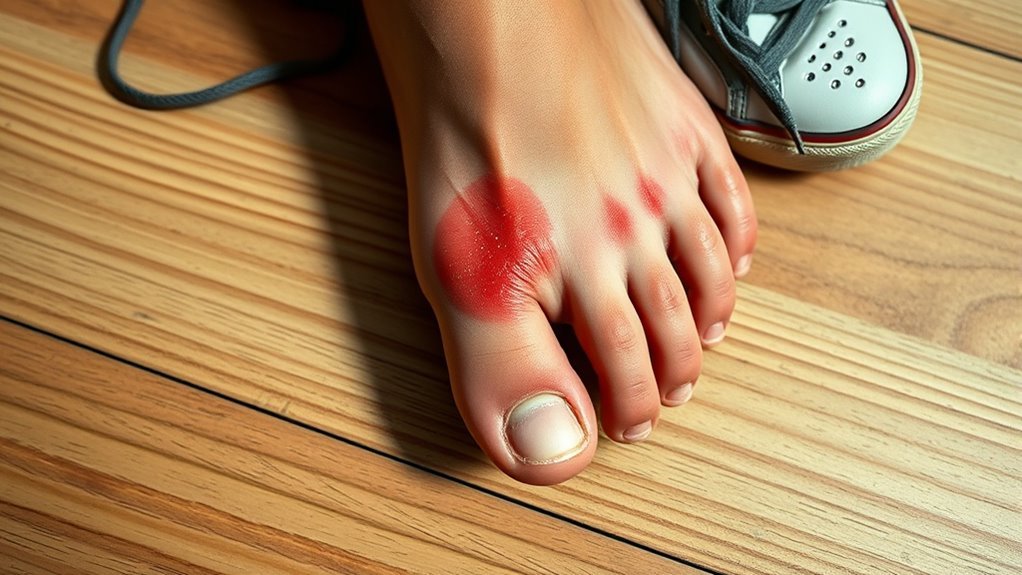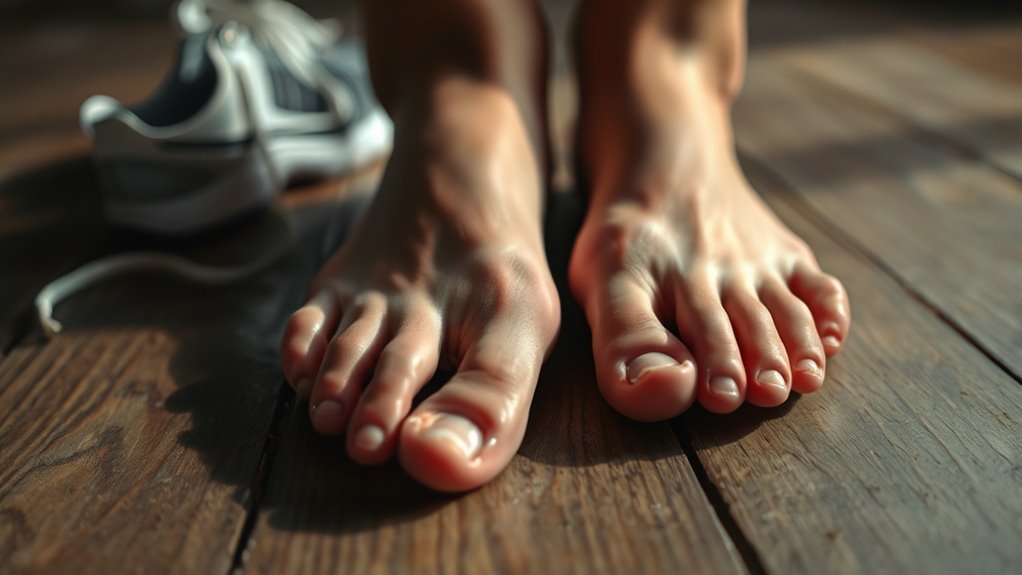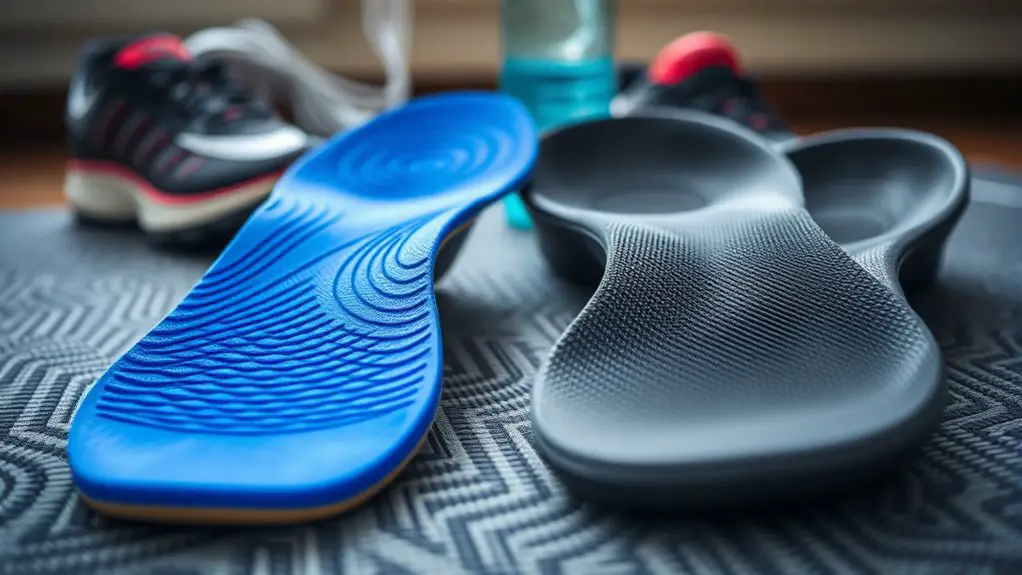When you run without shoes, your mechanics change considerably. You'll likely shift from a heel strike to a midfoot or forefoot strike. This alteration encourages lighter strides and better ground connection. Your stride length may shorten, enhancing efficiency. Additionally, running barefoot activates different muscles, improving stability and proprioception. While these changes can reduce injury risk, it's crucial to change gradually. Discover more about how this shift impacts your running experience.
The Evolution of Running Shoes
As you explore the history of running shoes, you'll find that their evolution parallels advancements in technology and our understanding of biomechanics. From simple leather sandals to modern marvels, shoe technology has transformed the way you experience freedom on the run. Historical footwear often prioritized durability over performance, with many early designs lacking the support and cushioning we now consider essential.
As innovators began to study how the foot interacts with surfaces, they developed shoes tailored to enhance your natural mechanics. The introduction of lightweight materials and specialized cushioning systems revolutionized the running experience, allowing you to feel lighter and more agile. Each new design reflects a deeper understanding of how to protect your feet while maximizing comfort and efficiency. This journey through time showcases the commitment to giving you the freedom to run further and faster, ultimately enhancing your connection to the ground beneath you. Additionally, understanding midfoot strike can help you choose footwear that complements your running style.
Understanding Barefoot Running
Barefoot running can transform how you strike the ground, promoting a more natural foot strike. You'll also notice an increase in proprioception, helping you become more aware of your body's position. Plus, running without shoes strengthens your foot muscles, leading to better overall stability and performance.
Natural Foot Strike
When you run without shoes, your body naturally adapts to a different foot strike, which can considerably enhance your running efficiency. This shift often leads to a more natural biomechanics pattern, allowing your feet to land with a softer touch, reducing impact on your joints. You'll notice how your body instinctively responds to the ground, thanks to the sensory feedback your bare feet receive. This connection to the earth encourages a more fluid stride, freeing you from the constraints of traditional running shoes. Embracing this freedom can lead to a more enjoyable running experience, where each step feels harmonious and effortless. By tuning into your body's signals, you can truly discover the joy of running in its most authentic form.
Increased Proprioception
Running without shoes heightens your body's awareness of its position in space, known as proprioception. When you ditch those shoes, you tap into a world of balance awareness that lets you feel each subtle shift in your body. You become more attuned to the surfaces beneath your feet, whether it's grass, gravel, or asphalt. This sensory feedback enhances your running experience, making each step more intentional and freeing. You'll discover that your body naturally adjusts to maintain stability, allowing for a more fluid and responsive run. Embracing this connection with the ground fosters a deeper sense of freedom, empowering you to move in ways you might not have thought possible. So, go ahead—feel the world beneath your feet!
Strengthened Foot Muscles
As you embrace barefoot running, you'll quickly notice how your foot muscles become stronger and more resilient. Without the artificial arch support of shoes, your feet adapt, engaging muscles that might've been dormant. This newfound strength enhances foot stability, allowing you to navigate uneven terrain with confidence. You'll feel the ground beneath you, which not only sharpens your balance but also empowers your natural movement. Over time, your arches will strengthen, adapting to the demands of running without the cushion of traditional footwear. Embracing this freedom means your feet can function as they were meant to, reducing injury risk and promoting overall foot health. Celebrate this journey to stronger feet, and enjoy the liberating experience of connecting with the earth.
Changes in Foot Strike Patterns
Though many runners may not realize it, switching to a barefoot or minimalist shoe approach can considerably alter foot strike patterns. When you trade your cushioned shoes for a more natural feel, you might find yourself landing differently. Instead of the typical heel strike, you may notice a shift toward a midfoot or forefoot strike. This change in foot strike isn't just about the surface beneath your feet; it's a transformation in your landing mechanics that encourages a lighter, more responsive stride.
You'll likely feel more connected to the ground, allowing your body to adapt and respond more efficiently. By embracing this new way of running, you can enhance your overall experience and reduce the risk of injury. Additionally, improving your grip strength can further support your running mechanics, as it contributes to overall stability and coordination. Remember, it's not just about running; it's about discovering the freedom to move in a way that feels right for you. So, enjoy the journey as you redefine your foot strike and running style!
Impact on Stride Length and Frequency
Shifting your foot strike patterns can greatly influence your stride length and frequency. When you run barefoot or in minimalist shoes, you might naturally make stride adaptations that promote a quicker cadence. This change often leads to shorter, more efficient strides, allowing you to maintain speed without the heavy impact associated with traditional running shoes.
As you experiment with different foot strikes, you'll likely notice frequency modulation—your step rate adjusts to optimize your form and energy efficiency. Increased awareness of how your feet connect with the ground helps you find a rhythm that feels liberating.
Embracing these natural shifts can enhance not just your running experience but also your connection to the ground. Ultimately, tuning into these stride dynamics empowers you to run with greater freedom and joy, releasing your potential as a more fluid and responsive runner.
Muscle Activation and Strengthening
When you run without shoes, your body engages different muscles more effectively, leading to improved strength and activation. This shift in muscle recruitment means your feet, calves, and stabilizing muscles work harder, fostering a natural strength adaptation that enhances your overall performance. You'll notice that as you ditch the shoes, your body begins to adapt to the demands of barefoot running, promoting resilience and agility.
This increased muscle activation not only strengthens your lower limbs but also encourages better alignment and posture, allowing you to move freely and with confidence. You'll likely feel more connected to the ground, which can empower your run in ways you never thought possible. Embracing this natural approach can release your potential, leading to a stronger, more efficient running style. Additionally, core strength plays a vital role in improving stability and control during your run, further enhancing your performance. So, take off those shoes and let your body revel in the freedom of movement and strength it craves.
The Role of Proprioception
As you embrace barefoot running, you'll also notice a significant enhancement in your proprioception—the body's ability to sense its position and movement in space. This heightened sensory awareness is essential for developing agility and balance. Without the cushioning of shoes, your feet receive more proprioceptive feedback, allowing you to navigate different terrains with greater confidence and fluidity.
Here's a quick overview of how proprioception plays a role in your running experience:
| Aspect | Effect on Running | Benefits |
|---|---|---|
| Proprioceptive Feedback | Increased awareness of foot placement | Enhanced stability and control |
| Sensory Awareness | Improved response to terrain changes | Greater adaptability and speed |
| Balance | Strengthened core engagement | Reduced risk of injury |
| Agility | Faster reflexes and reactions | More efficient movement patterns |
Incorporating proprioceptive training into your routine can further enhance these benefits. Embrace this freedom in motion, and let your body reconnect with the ground beneath you!
Adjustments in Gait Mechanics
When you run without shoes, you might notice changes in your stride length and foot strike patterns. These adjustments can greatly impact your overall running efficiency and comfort. Understanding these variations can help you adapt your technique for a better experience on the ground.
Stride Length Variations
While many runners instinctively adjust their stride length when shifting to barefoot running, these changes can greatly influence overall gait mechanics. You might find that shortening your stride leads to improved stride efficiency, allowing for a more fluid and natural motion. This can enhance your connection with the ground, letting you feel the feedback from each step, which is often muted by shoes. By tuning into your body's signals, you can discover the ideal stride length that feels comfortable and liberating. Embracing this freedom means you can adapt your gait to minimize impact and maximize enjoyment while running. Ultimately, these stride length variations will help you become a more intuitive and efficient runner, unshackled from conventional footwear constraints.
Foot Strike Patterns
Since switching to barefoot running, you might notice a shift in your foot strike pattern that can greatly impact your overall gait mechanics. Many runners shift from heel striking to forefoot striking, which allows for a more natural, fluid motion. This change can reduce the impact on your joints, giving you a liberating sense of connection to the ground beneath you. With forefoot striking, your body absorbs shock more efficiently, enhancing your agility and speed. You'll likely feel lighter and more free as you adapt to this new style. Embracing these adjustments not only helps prevent injuries but also encourages a more mindful approach to running, letting you fully experience the joy of each stride.
Injury Risks Associated With Barefoot Running
As you shift to barefoot running, it's crucial to be aware of the potential injury risks that can arise. While embracing the freedom of running without shoes, you should focus on injury prevention. Your footwear choices play a significant role in how your feet adapt to this new style. Here's a quick overview of common injuries associated with barefoot running:
| Injury Type | Cause | Prevention Strategy |
|---|---|---|
| Plantar Fasciitis | Overuse, improper form | Gradual adjustment |
| Stress Fractures | Increased impact | Strengthening exercises |
| Achilles Tendinitis | Sudden changes | Flexibility training |
| Metatarsal Stress | Lack of cushioning | Footwear choice awareness |
Incorporating strengthening exercises for the hamstrings can also help mitigate some of these risks.
Transitioning to Minimalist Running
Shifting to minimalist running can feel liberating, yet it demands careful consideration of your body's adaptation process. As you embrace minimalist footwear, you'll likely experience a newfound connection with the ground beneath you. Start slowly; your feet and legs need time to adjust. Gradually introduce natural surfaces like grass, dirt, or sand to your routine, allowing your muscles to strengthen and adapt. Remember that proper warm-ups and stretching are crucial for preventing injuries during this transition. Listen to your body—if you feel discomfort, take a step back. Incorporating short runs into your week can help ease the change, building confidence and strength. Focus on your form; a lighter, more efficient stride will emerge as you adapt.
Benefits of Running Without Shoes
Running without shoes offers a unique opportunity to enhance your overall performance and connection to the environment. Embracing barefoot running lets you experience the ground beneath your feet, fostering a sense of freedom and awareness. In this benefits overview, you'll discover how ditching the shoes can improve your running mechanics, helping you develop a more natural stride.
The barefoot advantages aren't just about feel; they can lead to stronger foot muscles and better balance, reducing your risk of injury. With each step, your body learns to adapt, enhancing proprioception and alignment. You'll also notice improved cadence and efficiency, allowing you to run farther with less effort. Additionally, mobility training can further enhance your running technique, promoting fluid movements and reducing the likelihood of strains.
Ultimately, running without shoes invites you to reconnect with your instincts, promoting a more enjoyable and liberating experience. So, why not give it a try? Release your potential and feel the ground as you run wild and free.
Frequently Asked Questions
How Do Weather Conditions Affect Barefoot Running?
Oh sure, running barefoot in the rain sounds like a blast, right? But when weather conditions turn sour, your feet might disagree. Temperature effects can leave your toes frozen or blistered, while terrain challenges like mud or rocks become your new best friends—or enemies. You'll find that freedom comes with a price; dodging puddles and maneuvering icy paths isn't exactly a walk in the park! So, embrace the elements, but tread carefully!
Can Barefoot Running Improve My Overall Running Speed?
Barefoot running can definitely boost your overall running speed. By connecting directly with the ground, you'll enhance your running efficiency, allowing for a more natural stride. This freedom from shoes can improve your foot strength and biomechanics, leading to quicker, more agile movements. As you adapt, you might even find your speed improving as your body learns to run more fluidly. Embrace the journey; it could transform the way you run!
What Surfaces Are Safest for Barefoot Running?
When you're considering barefoot running, the surfaces you choose can make a big difference in safety and comfort. Grass trails are ideal; they offer a softer landing and reduce the risk of injury. Urban pavements, on the other hand, can be harsher and might lead to discomfort or cuts. To truly embrace the freedom of running barefoot, stick to well-maintained grass trails when possible, and be cautious on harder surfaces. Your feet will thank you!
How Long Should I Run Barefoot Initially?
When you start running barefoot, it's tempting to go all out, but remember, your feet need time to adapt. Begin with an initial distance of just 5 to 10 minutes on soft surfaces. As your feet strengthen, gradually increase your running time and distance. Picture your feet embracing the freedom of the ground beneath you, connecting in a way they haven't before. Enjoy the journey, but listen to your body to avoid injury!
Are There Any Age Restrictions for Barefoot Running?
There aren't strict age restrictions for barefoot running, but it's important to evaluate child development and foot health. Kids generally have more adaptable feet, making them more suited for barefoot experiences. However, you should ease into it, allowing their feet to strengthen over time. Everyone deserves the freedom to run naturally, but you'll want to monitor how their bodies respond and guarantee they're comfortable with the shift. Enjoy the journey!




